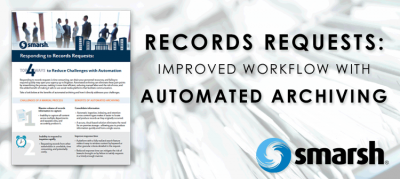i360Gov special reports and whitepapers are free of charge to all registered i360Gov users. Click on the report title to download the PDF. You will be taken to a short registration page. Registration is free, and you only have to register once for access to all i360Gov content. If you have already registered, simply log-in at the prompt.
2023 Data Storage Trends
2023 brings with it an extraordinary amount of data. It’s believed that the world is now producing and consuming close to 100 zetabytes of data every year.The Benefits of IT Modernization for Federal Agencies
The White House has prioritized IT modernization to make the Federal government more efficient and cost-effective. A more efficient Federal government that does more with less is a government well positioned to serve the needs of its citizens in the 21st century.Data Protection in 2023 and Beyond
With sophisticated cyber threats on the rise, the Federal government needs to take action. Larger data stores and evolving technology standards mean that Federal agencies must keep pace to mitigate risk.The Benefits of HCI for Federal Agencies
As data storage and management becomes more costly and complex, many organizations, including Federal agencies and contractors, are moving toward hyperconverged infrastructures (HCI).2023 Data Storage Trends
2023 brings with it an extraordinary amount of data. It is believed that the world is now producing and consuming close to 100 zetabytes of data every year. Now more than ever, organizations of all sizes need to understand how to store, protect and use the vast amounts of data they create and maintain on a daily basis.View Point: Storage On-Demand
With Big Data analytics and visualization delivering big results at the expense of capacity and processing, it’s become more critical – and more difficult – for federal agencies to accurately estimate storage and technology needs.AI and HPC for Government Enhance Public Service and Security with Artificial Intelligence Powered by High Performance Computing Systems
Advanced computing is changing how governments can approach tough challenges. This data explosion has created an ideal environment for government agencies to use advanced computing technologies to add immeasurable value to the lives of citizens. High Performance Computing (HPC) is the technology that powers analytics and artificial intelligence (AI) algorithms capable of filtering, associating, prioritizing, classifying and measuring massive amounts of data. Enhance public service and security with artificial intelligence powered by High Performance Computing systems. This eBook provides an overview of AI and Ready Solutions.The State of Cybersecurity
Implementing a Zero Trust architecture can be daunting. Not only does Zero Trust mean reconsidering nearly every part of your security infrastructure, it also means choosing a starting point that makes the most business sense for your organization, and actually beginning a transformation that may take years to complete. Every organization presents a unique case, with its own risk tolerance, operational requirements, regulatory environment, userbase, data storage needs, and growth potential. The good news is that each of the software solutions and behavioral shifts that together make a Zero Trust architecture possible also offer concrete advantages of their own. Deploying a cloud access security broker or implementing an app-based or token-based multi-factor authentication system can deliver greater ease of use and greater security, even if you don’t yet have the time, budget or expertise to comprehensively adopt Zero Trust.Innovating State and Local Government with Dell Technologies Solutions
State and local governments look to technology and information to help improve the quality, speed and responsiveness of their services and operations. Data plays a key role whenever constituents interact with state and local governments, when technologists plan and manage services, and when officials make decisions. How well government entities manage and safeguard data is key to their service delivery and improving the constituent experience.How Intrinsic Security Protects State and Local Government
With an intrinsic security approach, you can put security where it needs to be: at the foundation of your organization. Dell Technologies can help you leverage your infrastructure to help turn your devices, apps and users from points of vulnerability to points of protection. Learn how Dell Technologies enables a digital workplace to help employees work from anywhere.Cyber Protection and Recovery for Government
Cyber-attacks at the rate of one happening every 11 seconds have become a serious and continuous threat to organizations of all sizes and verticals. With the sprawling IT footprint, Federal Government agencies are no exception to this threat. The average cost of a cyber-attack for US Federal agencies is estimated to be $13.7M in the annual Cyber Security publication by the IT Services major Accenture. While 100% immunity is not practical, IT Organizations can do a lot to significantly improve the cyber resiliency of the systems to protect business-critical data and setup systems for faster recovery of business operations.A Partnership of Trust: Dell Supply Chain Security
A single ransomware incident can lead to operational disruptions, lost revenue, compromised data, diminished productivity and a tarnished brand or corporate reputation. For these reasons, customers are rightly seeking assurance that the technology products they purchase have not been tampered with or maliciously modified, jeopardizing their ability to protect the data they intend to store and process on those devices.The Four Infrastructure Essentials for AI/ML Data Pipeline and Data Lake Environments
Modernization: Creating the Right Data Pipeline Infrastructure Environment for SuccessRedefining Modern Enterprise Storage for Mission-Critical Workloads
Digital business for IT organizations has evolved, and organizations are faced with greater storage needs. Maintaining resilient, efficient operations has become essential, and just a short period of downtime can be costly. Modern storage systems must adapt to increased demands of organizations to deliver greater flexibility, scalability, data movement, application support and infrastructure modernization. IT organizations must demand more from their IT vendors. Dell Technologies, a leader in modern enterprise storage, continues to innovate and evolve its technology to meet the mission-critical needs of the most demanding IT environments.Dell EMC PowerMax: Highly Efficient and Resilient Storage for Large, Enterprise-mixed Workload Consolidation
Validation Report: Dell EMC PowerMax Storage SolutionDell EMC PowerMax: End-to-End Efficient Encryption
Securing sensitive data is one of the greatest challenges faced by organizations today. Increasing regulatory and legislative demands and the constantly changing threat landscape have brought data security to the forefront of IT issues. Dell EMC™ PowerMax end-to-end efficient encryption addresses these challenges. This document describes how Dell EMC™ PowerMax end to end encryption protects data confidentiality by encrypting data from the application host with Thales software. Incorporating both encryption technologies allows you to take advantage of the space-saving data reduction while ensuring that all sensitive data is secure.Extend Your Private Cloud Into AWS GovCloud with Nutanix Clusters
Learn how FedRAMP Authorized Nutanix Government Cloud Services helps enable Public Sector organizations get to a Hybrid Cloud Environment. Government organizations implementing Cloud Smart mandates can now consider Nutanix Clusters on AWS GovCloud to manage applications, workloads and infrastructure in multiple private and public clouds as a single, unified cloud.
The Total Economic Impact™ Of Deploying Dell EMC PowerScale Storage
Cost Savings And Business Benefits Enabled By Deploying Dell EMC PowerScale Storage
Forrester’s interviews with four Dell EMC PowerScale
customers found cost savings and benefits in the following
categories: storage workload optimization savings, storage
management efficiencies, data center space savings, and
revenue generating business value added. Interviewed
customers noted that in addition to scalability and cost
effectiveness over their previous systems, the performance
and resiliency of their PowerScale clusters help their
organizations support fast and unpredictable business
growth. Customers reported the ability to run a wide variety
of workloads on the same data set within a single platform.
Software-defined Architecture—The Foundation of IT Infrastructure Transformation
Software-defined storage promised freedom from hardware lock-in. It has delivered, in part, on that promise. However, procuring enterprise storage technology as software separate from hardware creates new complexities. When IT organizations are aiming to add infrastructure agility and flexibility, the architecture becomes more important than the delivery model. Solutions featuring a software-defined architecture will provide the greatest value, whether they are deployed and delivered as software, as an array, as hyperconverged infrastructure, or as something else.Dell Technologies PowerScale: Software-defined File Storage Offering Exceptional Flexibility
Unstructured data has risen recently—both in terms of the capacity it consumes and its importance to businesses. Modern data demands greater scalability and hardware flexibility, and unstructured storage architecture should be designed with a data-first mindset. Fortunately, with its recent OneFS release, Dell Technologies is providing digital organizations greater choice, flexibility, and control of data with its PowerScale (formerly named Isilon) technology.Building the Foundation for a Smart City
The City of Doral built a hyperconverged infrastructure on Dell Technologies to power Smart City initiatives and create new and improved digital services for its residents.New Efficiency, New Insights: Put Unstructured Data to Work at the Edge, the Core, and the Cloud
Federal teams need new options to manage the growing volume of unstructured data generated from many different sources and devices, including mobile units, artificial intelligence and machine learning solutions, Internet of Things devices, video workloads, smart equipment, and drones.The IT Leader’s Guide: Delivering an Effective Multi-Cloud Strategy in the Public Sector
Digital Transformation is no longer a buzz word, but rather a direct reflection of the massive technology changes happening today. Organizations throughout the public sector are taking big strides to capitalize on these changes and deliver better community experiences. This eBook from Dell Technologies and Intel® will provide guidance to successfully transform infrastructure and operations across six key facets of your technology landscape. Armed with this knowledge, you can build a winning hybrid cloud strategy spanning multiple environments that accelerates innovation, meets the massive growth of data, and reduces cost of delivering IT services across the organization.Dell Technologies and VMware: Working Better Together for State and Local Government
Together, Dell Technologies and VMware accelerate digital transformation—enabling state and local government organizations to deliver innovative resident experiences, simplify management, secure data everywhere, and drive new digital capabilities. This solutions guide highlights core partner solutions most beneficial to government.The New Remote Work Era: Trends in the Distributed Workforce
Thanks to improvements in digital workspace technology over the past several years, distributed workforces - with all their benefits - became an increasingly viable option for businesses. But despite the promise of cost savings, business agility, and employee flexibility, leadership inertia and fears thwarted most widespread attempts at this paradigm shift.Enterprise Cloud for Federal Systems Integrators
Multi-cloud and hybrid cloud environments are rapidly becoming the predominant strategy for Federal agencies. However, without a clear plan of action for implementation and ongoing usage, government agencies often fail to capture and capitalize on the promised economies that cloud has to offer. That’s where Federal Systems Integrators (FSIs) can shine.
In-Demand FedRAMP Offerings for Government: DaaS & Multi-Cloud Cost Optimization
an i360Gov Webcast Digest
The Federal Government relies on the Federal Risk and
Authorization Management Program designation (FedRAMP) to
ensure agencies only deploy workloads on cloud platforms
certified and accredited to meet the highest standards of
security and interoperability. FedRAMP also supports Federal
agencies when making strategic decisions on where to run
sensitive U.S. government workloads.
Podcast: FedRAMP Offerings for Federal Government
The Federal Government relies on the Federal Risk and Authorization Management Program designation (FedRAMP) to ensure agencies only deploy workloads on cloud platforms certified and accredited to meet the highest standards of security and interoperability. FedRAMP also supports Federal agencies when making strategic decisions on where to run sensitive U.S. government workloads.Solving for X: Addressing Critical IT Challenges In Higher Education
Colleges and universities are grappling with a host of complex issues capable of shaking the very foundations of Higher Ed. Discover how forward-thinking leaders are solving critical challenges in Higher Ed with flexible, adaptable IT that enables the responsiveness and agility to support an array of learning and research environments -- even under current resource and budget restrictions.Understanding the Fundamentals of Cybersecurity
From ordering office supplies to international money transfers, a secure and reliable network is imperative. Are you taking advantage of the fundamental services like DNS to ensure your network is protected? Read more about how the fundamentals can make a difference.Building a Network to Meet Today's Demands
Building, maintaining and operating a network in today’s IT environments can be complicated. Organizations and government agencies need to take advantage of every operational efficiency they can, which is why automation tools such as Ansible have become the industry standard for allowing IT teams to automate tasks. Read more about how Red River and Red Hat’s Ansible solution are fundamental tools for every network.Making the Grade for Federal Digital Transformation
Checked your FITARA score lately? On track with OMB’s Datacenter Optimization Initiative (DCOI) and Cloud Smart Policy? Are you taking full advantage of the Modernizing Government Technology Act (MGT) or Technology Business Management (TBM) methodology? If your answer to any of these questions is no, you’re not alone. But it’s time to accelerate digital transformation to meet these mandates. Learn how federal agencies are modernizing IT to meet federal mandates and policy controls while continuing to support their missions in this special report.Contrail Enterprise Multicloud
Contrail Enterprise Multicloud automates the transformation of multiple independent cloud infrastructures into a seamless managed multicloud, providing full control of and visibility into all services. Leveraging the principles of SDN and network overlays, Contrail Enterprise Multicloud extends managed infrastructures from private clouds to physical network devices in data centers, cloud interconnects, WANs, and public clouds. Built on open APIs and standard protocols, Contrail Enterprise Multicloud removes the complexity of networking and automation by abstracting the operation of cloud environments, allowing users to focus on meeting mission need.
Juniper Connected Security In Action
Enabling automated threat remediation without impacting business continuity
Network deployments have significantly changed over the past
decade. Government agencies are rapidly moving to the cloud
and adopting new technologies such as Internet of Things
(IoT) and block chain, all of which are heavily dependent on
the network. Agencies are also increasing spending on
security to protect new and existing infrastructure, but the
breaches continue unabated. Internal records and citizen
information are still being stolen and sold to the highest
bidder, causing irreparable damage to agency reputations.
This begs the question—is government missing something
very fundamental in its approach to network security?
Video: Red River and AWS Managed Services
AWS helps manage your organization’s cloud, but who helps you manage your AWS? Red River Managed Services specializes in cloud — storage, migration, managing and more. Watch a short video with Red River’s Chief of Cloud, Larry Bowles and President of Red River Managed Services, Jason Waldrop to learn more about Red River’s AWS Managed Services portfolio.Viewpoint: Red River and Cisco Connected Classroom
Today’s classrooms are for more than just math and English — students learn to innovate, adapt and use technology. With Cisco Connected Classroom, students can become technologically savvy while learning in an engaging, flexible and technology-filled environment. Technology doesn’t have to be a distraction in the classroom: It can enable learning in core subjects, encourage good digital citizenship and connect students no matter their learning environment. Download Red River’s Viewpoint Connected Classrooms to learn more.State & Local Agencies Adopt As-a-Service Solutions in a Time of Pandemic Crisis
State and local governments are reacting to the COVID-19 pandemic by implementing new models of telework and remote-access IT solutions. As the pandemic response – and its lasting impact – are fully understood, many state and local governments are taking bold steps to avoid provisional fixes, thinking long-term, and avoiding solutions that may be costly or cumbersome to operate over time. As the full spectrum of IT models are considered, As-a-Service has emerged to satisfy continuity of operations mandates, as well as the tricky demands of security, up-time, lowered infrastructure requirements, BYOD, and interoperability. Read the report to learn more.Beyond Telework: How State & Local Government Agencies Are Transforming IT
Future-forward State and Local Government Agencies, like San Mateo County in CA, are moving beyond legacy telework and automation solutions to deliver sophisticated IT capabilities that enable continuity of essential services when crises occur -- and position them for success in the “new normal.”Extending Enterprise IT to Federal Workers with As-a-Service Telework Solutions
Even before the COVID-19 crisis, Federal agencies were dealing with outdated, inadequate, and less-than-secure legacy Telework solutions. Find out how As-a-Service Telework solutions can deliver full access to the enterprise IT Federal agency workers need from home right now.eBook: Let's build the future of government, together.
There are gaps within many of today’s government solutions. Commercial, academic, and research organizations have long provided solutions that have been adapted for government — and used to advance critical national security missions and society as a whole. NS2 Labs provides capable and productive spaces where the industry's top minds can work together on the most pressing business challenges customers face in the digital era, bringing together the elements needed to make co-innovation among partners and customers successful.Is Your End-User Experience Creating Happier End Users?
End-User Computing (EUC) environments—including both virtual desktop infrastructure (VDI) and Desktop-as-a-Service (DaaS) solutions—are rapidly replacing physical desktops and laptops in the workplace. These solutions enable your organization to deliver new applications using a Software-as-a-Service (SaaS) model, more easily support bring-yourown-device (BYOD) and choose-your-own device (CYOD) initiatives and increase security from end to end.Is Your IT Team an Engine for Innovation?
The right strategy to transform your IT as an innovation incubator instead of a reactive support shop involves a blend of public and private cloud services. Your organization should be able to leverage the elastic nature of public cloud services—along with the ease of management and usability—but with the security, control and performance of the private cloud.
Are You Unlocking the Value of Your Data?
Nutanix Makes Database Management Easy So Your DBAs Have More Time to Focus on Supporting New Initiatives
Acceleration is key to achieving ROI—doing things faster,
with greater efficiency, and adapting to changing needs with
less time required to pivot. This is where the real value in
acceleration lies—taking the lead on innovation. Increased
speed and efficiency allow your users to have the right
information at the right time for data-driven
decision-making.
Podcast: Modernizing Federal Healthcare IT with Public and Private Cloud
The landscape for Clinical and Non-Clinical Federal Healthcare is changing. As hospitals adopt more advanced IT tools and applications, healthcare professionals are pushed towards learning new technical skill sets just to stay efficient. i360Gov sits down with Nutanix’s Kip Downer and Bill Hackley to discuss the impact of public and private clouds on modernizing and simplifying Federal Healthcare IT.Red River and NetApp Implement a New Network Solution
A federal healthcare agency had a network that was considered out-of-service and needed to be replaced across all 145 facilities. Download the case study to learn how Red River and NetApp were able to successfully implement a new and improved network solution.Red River and Dell Technologies Carry Enterprise Security to the Future
A large civilian agency was in need of a major security upgrade that met the requirements set by the Department of Homeland Security and could be upgraded as the agency continues to grow. Download the success story to learn how Red River and Dell Technologies worked together to implement an effective solution.Results of New Executive Survey of Federal Employees on the Adoption of DevSecOps
*What is DevSecOps? How is it being implemented in Federal Agencies?*
Performance at Scale
10 million issues and beyond with Jira Data Center
Like many Jira Software customers, you might find yourself
dealing with an instance (or multiple instances) of Jira
that has grown to massive scale. Administration of the
application and hardware has become a full-time job as you
struggle to keep up with the demands of this mission
critical application. You find yourself in need of a
solution that makes your life easier and can grow with your
organization.
State and Local Governments Embrace Next-Gen IT Infrastructure
Can cities, counties, municipalities, and other governing entities provide services to meet the high expectations of their citizens? The expectations established by citizens interactions with the world’s top tech commercial companies?Building a NextGen E-discovery Playbook for Public Sector Organizations
You’ve collaborated with your government colleagues on Microsoft Teams or Skype for Business. You’ve reached out to community members via social media. You may or may not use a government issued device to get work done away from the office. And, you’ve seen the court cases referencing public records requests and missing text messages. As technologies for communication and collaboration continue to grow beyond traditional channels like email and static documents, how should a public sector organization adjust its e-discovery playbook? That’s the question we aim to tackle in this brief guide.
USC Marshall School of Business Supports Educational & Research Projects with Nutanix Enterprise Cloud
Nutanix Hyperconverged Platform Provides the Ability to Quickly Deploy Compute Resources to University Staff, Faculty, and Students
Nutanix Enterprise Cloud simplifies infrastructure
deployments and ongoing management. By migrating from blades
to the hyperconverged solution, the University was able to
cut its data center footprint and power consumption at the
University’s colo facility in half. The end result is the
increased ability to support faculty research projects and
improve student learning outcomes.
Modernizing IT Infrastructure
Delivering Citizen Services with Transformative Technologies
In an effort to solve the traditional challenges of legacy
infrastructure, many organizations have opted to implement
Cloud-First strategies. Making the switch the Cloud offers
an array of benefits, including increased efficiency,
elastic workloads, faster time to market for applications
and services and a fractional consumption model, which
enables organizations to pay only for what they need.
Pennsylvania Public School Relies on Nutanix to Power Education, Administration
Nutanix Xi Leap Disaster Recovery Keeps Critical Data Safe
The motto of the Avon Grove School District is “We
champion innovation. We celebrate community. We demonstrate
sportsmanship. We define school spirit.” Technology is
instrumental in helping the District achieve each of these
objectives. Its IT organization is committed to driving
innovation with the latest technology, including a
virtualized infrastructure—without losing sight of the big
picture: empowering teachers to support student learning.
UCSD Takes Charge of its Multi-Cloud Environment with Nutanix Beam
Achieving Cloud Cost Control and Enhancing Cloud Security for Improved Instruction and Research
Serving almost 40,000 students from across the world,
University of California, San Diego is a leading public
university. Public cloud services play a vital role in
supporting research and instruction at the institution, but
the IT team lacked insight into how and where these services
were being used, their costs, and their levels of security
and compliance. The University deployed Nutanix Beam to gain
visibility and control over its cloud usage and improve
compliance with government and academic regulations. The
solution gives faculty and researchers the freedom to
continue to take advantage of the agility and flexibility of
cloud, while managing costs, minimizing risks, and
streamlining administrative tasks.
How Do You Automate Your IT?
In a quest to automate frequently repeated technology tasks, Red River discovered Red Hat's Ansible Framework. Read how Ansible helped Red River's Innovation Center automate user creation requests - reducing turnaround time from 30 minutes to 2 minutes per user. Red Hat's Ansible Framework is:
Data for Managed Services
On the Road with Big Data Beard Podcast
Red River and Dell Technologies join the Big Data Beard
podcast on their road trip across America. Listen as they
discuss how Red River is helping its customers make sense of
their data and turn insights in actionable intelligence.
Empower End-Users With Better Experiences
Solutions for any device, anywhere, any time
The goal of end-user computing is to provide the absolute
best experience for users. However, if the virtual desktop
experience is not as good as the one provided by their
previous physical hardware, users will soon be wishing they
could roll back to that earlier environment. Users need to
find their experience is just as fast (or faster), extremely
stable, and easy in order for your EUC initiative to
succeed. If they don’t experience this, your EUC
initiative will fail.
Top 20 Hyperconvergence Questions Answered
Today, hyperconverged infrastructure (HCI) which consolidates compute, storage, networking, and virtualization in one solution, is the infrastructure of choice for companies that want to stay competitive and ensure their datacenters are cloud-ready. Yet, the change feels difficult for some companies — and others just aren’t aware of what HCI is, what it does, and its benefits.Designing and Building a Hybrid Cloud
Enterprises are turning to hybrid cloud to modernize IT for the digital era. But, given the significant complexity that still exists today in cross-cloud management and integration, many enterprises are struggling to create an effective hybrid cloud strategy.
Thrive or Just Survive? You Choose.
Unlock Your Data’s Full Potential
Your business is housing a gold mine of data and is trusting
your team to manage, protect, and mine insights from it.
This can be a daunting task, especially considering that
today, data is being created faster than ever before —
over 2.5 quintillion bytes per day. This presents both a
unique opportunity and challenge for your business. In order
to extract value from data, your business needs an efficient
means of not only collecting, but also storing, processing,
analyzing and utilizing data.
WiFi 6 Is Moving Communication Into The Future
Red River Insights Podcast Part 1 of 2
Wi-Fi 6 and 5G will usher in a new wireless world, reshaping
the way we learn, connect and do business. These
technologies are significantly faster, with greater capacity
and improved latency. They will change how we interact with
each other, and will ultimately mark the future of
communications. Listen to the first podcast with Red River
mobility expert Bill Halpin on how these technologies are
reshaping our world.
Secure Open Roaming is Now Possible
Red River Insights Podcast Part 2 of 2
Wi-Fi 6 and 5G will usher in a new wireless world, reshaping
the way we learn, connect and do business. These
technologies are significantly faster, with greater capacity
and improved latency. They will change how we interact with
each other, and will ultimately mark the future of
communications. Listen to the second podcast with Red River
mobility expert Bill Halpin on how these technologies are
reshaping our world.
Discover The Monitoring Solution We Trust
A Red River Insights Podcast
To support aggressive growth targets, Red River needed to
modernize and replace its legacy monitoring technology for
service delivery. ScienceLogic’s hybrid and multi-cloud IT
monitoring platform offered the robust, stable architecture
the company needed. Learn how ScienceLogic cut onboarding
time from weeks to days, lead to expanded customer scopes
and improved customer service.
Manufacturing Success within the Cloud
Traditional manufacturing ERP software solutions often involve painful, time-consuming implementations and problematic periodic updates. Consequently, many manufacturers go years without upgrades—doing without the latest features and functions to run their businesses.Protecting Data Capital in Your Organization
The digital era that organizations now find themselves in means that unprecedented data growth is unavoidable. Next-generation technologies and workloads (e.g. IoT, AI) in particular are at the heart of many organizations’ digital transformation plans, and they create significant quantities of data and amplify this growth.
Powering the Journey to AI
On The Road with Big Data Beard Podcast
Red River and Dell Technologies join the Big Data Beard
podcast on their road trip across America. Listen as they
discuss how Red River is helping its customers make sense of
their data and turn insights in actionable intelligence.
Podcast: Technology Trends - The Impact of Smart Cities with Nutanix
i360Gov sits down with Tim Wallace, Head of Public Sector Industry Solutions at Nutanix, to discuss the impact surrounding Smart Cities. Many communities have begun using advanced technology to adopt a smart city mindset. Whether it’s converting the kinetic energy of automobiles to power streetlights or simply painting rooftops white to reflect solar heat, smart city projects are becoming more common.The Next Evolution of HCI is Here
A new subcategory of NetApp’s hyperconverged infrastructure (HCI) has been created – called disaggregated HCI – with the intention of helping customers solve their business challenges in a non-linear way. This is the first hybrid cloud infrastructure for everything that matters, making management easy, increasing efficiency and reducing costs.Streamline Your Service Contracts
Managing service contracts and warranties can be a daunting task, especially when you have multiple overlapping contracts for systems and components. When something needs service, which contract covers it? Are contracts up to date? How are you managing security updates across different devices?The State of Electronic Communications in Government
The digital revolution has transformed the way government functions - but policies and practices aren't always up to date with the reality of how employees work in the 21st century.The 2019 Public Sector Guide to Text Messaging Policy and Retention
This guide contains practical steps to help public sector organizations and departments develop a text message policy and retention strategy that will improve the efficiency of fulfilling public records requests while reducing the overall drain on resources. It also outlines some smart text recordkeeping practices, so you’ll be better prepared to respond to open records requests or other e-discovery needs when they arise.
Solving Data Analytics Challenges
On the Road with Big Data Beard Podcast
Red River and Dell Technologies join the Big Data Beard
podcast on their road trip across America. Listen as they
discuss how Red River is helping its customers make sense of
their data and turn insights in actionable intelligence.
Success Story: Red River and RSA Enhance Security for Federal Agency
According to a recent global survey, security breaches have risen by 67% over the last 5 years. This eye-opening statistic has organizations looking to shore up their cybersecurity solutions. Learn how Red River's engineers recently helped a federal customer upgrade to a more robust security solution revolving around RSA Netwitness, a robust monitoring platform that provides security forensics, incident detection and response, and investigative analytics for Security Operations Centers.Think you know the best path to cloud?
Hear from Red River's Cloud Chief, Larry Bowles, as he shares recommendations regarding best practices for cloud adoption and dispels myths about Amazon Web Services and GovCloud. Red River is an Advanced Consultant Partner for Delivery and Execution, as well as an Authorized Reseller for Amazon Web Services, a leading cloud provider.Embarking on the path to cloud?
Red River and Amazon Web Services are trusted resources when it comes to Cloud. Listen to this podcast to hear how Red River helps customers migrate to the cloud with a full lifecycle of services - from consulting to managed services. Red River is not only an Advanced Consultant Partner for Delivery and Execution, but it's also an Authorized Reseller for Amazon Web Services, a leading cloud provider.Leveraging dependencies between data centers and the cloud
While the Cloud can be a powerful upgrade to legacy IT infrastructure, it is not the panacea that many once thought. Depending on unique workloads and capacities, a traditional data center may be a better fit for applications, data and functionality not particularly suited to a Cloud environment. Used effectively, Cloud can reduce costs, improve agility and enhance security. However, taking an all-or-nothing approach can result in downtime, reduced productivity and frustration.Red River and NetApp Optimize the U.S. Navy’s Maintenance and Storage Capabilities
Red River and NetApp partnered together to develop a storage solution for the U.S. Navy that was flexible, secure, highly redundant and capable of making data accessible even in the event of system downtime. Red River implemented NetApp’s Shared Storage Infrastructure solution, which allows users from all over the world to collect data, store this data within a secure private cloud and retrieve this data whenever they need it, regardless of their location.Here's Why You Should Take a Securtiy-First Approach
It should be news to no one that the number of cyber attacks and data breaches continues to rise. More than three-quarters of organizations have been victims of one or more successful cyber attacks.
Industry Insights
An IT Innovation Insider eBook
Eight years after the cloud-first policy, agency spending on
cloud computing services surged to $4.1 billion, according
to analysis from Bloomberg Government. BGov says cloud
spending grew by 9% among civilian agencies and by almost
30% among defense agencies from fiscal years 2017 to 2018.
The growth curve is expected to continue on the upward climb
as the Trump administration finalizes its cloud smart
strategy as well as new contracts for common back-office
cloud services and shared services.
Surviving and Thriving in a Multicloud World
As cloud becomes mainstream, customers are beginning to realize the benefits from multiple technology investments. Organizations who are outpacing their peers in IT Transformation are investing primarily in three key technologies - data integration, cloud and AI. Data integration is table stakes for deriving maximum value from both cloud and AI. The three technologies combined multiply innovation for those organizations undergoing the fastest rates of IT transformation.Continuous Diagnostics and Mitigation
Established in 2012 by the Department of Homeland Security, the CDM program was designed to protect government data by providing federal agencies with an array of cybersecurity capabilities. Over the last several years, the CDM program has undergone several changes to better align with agencies' cybersecurity initiatives and help them develop an advanced cybersecurity risk posture.Transforming Government with Cloud Technologies
The cloud is ubiquitous. Whether we think about it consciously or not, almost all of us are using cloud services. That could be a music service such as Spotify, storage such as Dropbox, communications via Gmail, or a software-as-a-service application such as Salesforce. Cloud services touch all of our lives.Creating the Workplace of the Future with IoT
How and where government employees work has drastically changed over the years, thanks to smart technology and alternative arrangements such as telework. Some agencies are even investing in functional office spaces as a recruitment tool and a perk to keep current employees happy.Data & Defense: How to Boost Readiness
Defense and intelligence agencies want to leverage the data they collect so they can use artificial intelligence to enhance readiness – but most who run these programs don’t know how to get started and find it difficult to make the business case to their leadership.Intelligence at the Speed of Conflict
US ground forces handle massive amounts of information and data while working under unpredictable conditions. These conditions don’t always allow military intelligence analysts access to a technologically reliable way to share information. They must overcome both enterprise communication challenges, which force them to operate, at times, with little to no access to data, and information overload when connections are available. They must also find ways to deal effectively with the complexity associated with the wide variety of evolving data sources.Smarter Moves For Smart City Planning
The advent of the Internet of Things has ushered in the era of Smart Cities. More and more cities are leveraging the Internet to implement new processes and communication technologies to gather data and change the way they manage resources. But what is a Smart City—and what does it take to become one?
Endpoint Protection Buyers Guide
How to navigate a crowded vendor landscape and find the best endpoint protection solution
According to the 2018 SANS Endpoint Security Survey, more
than 80 percent of known breaches involve an endpoint.
That’s why finding the most effective endpoint protection
has never been more important. Unfortunately, with hundreds
of options on the market, all claiming the same
“next-gen” features, choosing the best endpoint security
for your organization can be challenging.
Faster Response with CrowdStrike and MITRE ATT&CK
How adopting a framework can optimize cybersecurity
Today’s threat landscape has created new challenges for
security analysts and incident responders, as the number of
alerts and their complexity have increased significantly.
Organizations with small IT teams are overwhelmed, often
lacking the time or resources to investigate every alert.
Failing to do so means a high-risk threat might go
unnoticed. This can result in a devastating breach, damaging
an organization's finances and reputation.
CrowdStrike Falcon Complete: How to Achieve Instant Cybersecurity Maturity for Organizations of All Sizes
Guidance for taking any organization to the highest level of endpoint protection regardless of internal resources
Organizations today have a wealth of security tools
available to them but many struggle to take full advantage
of the technology they have. Too often, this results in a
damaging breach that could have been avoided if their
solutions had been configured and updated properly or if
detections had been noticed and acted on. How well your
organization is doing at fully implementing its security
solutions, particularly endpoint protection technology, is a
reflection of your cybersecurity maturity.
Guide to Antivirus (AV) Replacement
What You Need to Know Before Replacing Your Current AV Solution
The Guide to AV Replacement provides in-depth information
from leading security experts that will guide you through
each phase of your decision-making process. From the
critical elements you need to consider, to how to evaluate
and review solutions, you’ll get expert advice that can
help you choose a security solution that best fits your
organization’s requirements.
Ransomware – A Growing Enterprise Threat
A deep dive into Ransomware’s evolution and why the Public Sector can’t afford to ignore it
The global WannaCry Ransomware attack that struck
enterprises across multiple continents is a grim reminder of
how prevalent these cyberattacks have become. Adversaries
are not only launching ransomware attacks against a wide
range of industries, they are consistently evolving their
tools, tactics and procedures (TTPs) to foil your
enterprise’s best cybersecurity strategies. A white paper,
"Ransomware - A Growing Enterprise Threat," offers in-depth
analysis of what ransomware is and explains why the public
sector can’t afford to ignore this increasingly
challenging cyber threat.
Hyperconverged Infrastructure with Nutanix
In the old days of IT, budget cycles and legacy hardware-centric architectures necessitated massive IT procurements with multi-year commitments – slowing down innovation as a result. Although less and less, those types of acquisitions still happen today, as a result of IT decisions being presented as ‘either/or’ propositions. But as IT evolves, and innovative options become more mainstream, agencies no longer have to choose between cloud (hot) or traditional data centers (not). In the post-cloud era, hybrid cloud platforms can recognize and manage resources across the entire enterprise, whether on-prem or off-prem, and deliver the agility, simplicity, and cost-effectiveness that cloud computing has promised.
Technology Trends to Watch
Paul Krein InsightsLIVE Trends Podcast
Automation, AI, Cloud, machine learning and other technology
trends offer insight into how the latest technologies are
empowering the federal workforce and changing the way
federal agencies meet mission-critical objectives.
Ready-Bundle Solutions Drive IT Modernization
Paul Krein Insights Solutions Podcast
With so many complex products on the market, it’s no
surprise more and more customers want to shift their focus
to solutions—bundled offerings that simplify complexity by
offering jumpstart capabilities.
Building a NextGen E-discovery Playbook for Public Sector Organizations
You’ve collaborated with your government colleagues on Microsoft Teams or Skype for Business. You’ve reached out to community members via social media. You may or may not use a government issued device to get work done away from the office. And, you’ve seen the court cases referencing public records requests and missing text messages. As technologies for communication and collaboration continue to grow beyond traditional channels like email and static documents, how should a public sector organization adjust its e-discovery playbook? That’s the question we aim to tackle in this brief guide.The 2019 Public Sector Guide to Email Policy and Retention
With email being a ubiquitous technology for close to two decades now, nearly all organizations have varying solutions for recordkeeping of the channel. Whether the solution is modern is another question entirely.From Automated to Comprehensive: What Child Welfare Organizations Need to Succeed
Worldwide, health and human services systems are facing economic and technological unsustainability and other serious challenges that threaten their efficacy. Existing systems of care, wellness and support must come together with technology, data and expertise in order to help people live healthier and more productive lives. An opportunity exists to address this need. By utilizing a vast amount of untapped data from a variety of sources — clinical, genomic, behavioral and social factors — it is now possible to unlock insights for a holistic view of an individual.Case Study: Hamburg Authority of Labor, Family and Integration
Government agencies (Jugendämter – Youth Welfare offices) in Hamburg, Germany sought to improve speed, efficiency, transparency and collaboration in handling allegations and managing cases of child abuse and neglect.Fraud Algorithms Master Class
Gain useful ideas from IBM Watson Health experts for algorithms across a variety of fraud scheme areas, such as claims coding, dental fraud schemes, NICU Level-of-Care upcoding, and best practices for program integrity in a managed care environment.
Red Hat Enterprise Linux version 8
Control, Confidence and Freedom with Red Hat Enterprise Linux
Before agencies and institutions can gain value from
leading-edge IT capabilities like data insights,
cloud-native development, artificial intelligence and the
Internet of things, they need to focus on optimizing the
infrastructure they have in place. Because it is the
infrastructure that powers the applications driving
business. So how can agencies and institutions optimize and
modernize today’s IT for tomorrow’s applications?
eBook: The IBM Watson Health Solution for Child Welfare
Many US child welfare organizations are transforming their Statewide Automated Child Welfare Information Systems (SACWIS) into the new vision of Comprehensive Child Welfare Information Systems (CCWIS). Now is a good time to consider how child welfare organizations gather, manage and use data, and how their systems enable them to protect children and strengthen families.Best Practices to Effectively Utilize the Billion Plus Dollars Legislated to Fight the Opioid Epidemic
See use-case analytics for making the most of administrative data to help size and stratify the scope of the opioid epidemic in your state. These analytic strategies inform data-driven decisions and the development of targeted interventions to make the most effective use of available funding. Use cases include examples of identification of substance use disorders across the state, availability and utilization of medication assisted treatment, focus on special populations and the use of data dashboards for monitoring performance on opioid related metrics.Take Control of Public Records Requests: A Maturity Model
Federal, state and local government agencies are working to develop more efficient and effective practices to ease and improve their efforts in disclosing records in response to requests sent under the Freedom of Information Act and other public records acts.Gartner’s Market Guide for ID Proofing and Corroboration
The identity of new customers cannot be absolutely verified ("proven"), but high confidence in identity is crucial to protect customers and revenue. According to the Gartner guide, “Security and risk management leaders must discard flawed legacy methods and embrace analytics that evaluate multiple positive and negative signals.”Federal Agencies Embrace Agile Security: How Atlassian Tools Help Agencies Infuse Security into Agile Development
Driven by the growing number of cybercrimes that target both public sector entities and private corporations, along with increasing pressure to upgrade security, comply with stringent regulatory oversight and migrate to cloud-based services, federal agencies are working to modernize and improve the agility of crucial security processes.Building the Business Case: Adopting Technology
Federal, state, and local government agencies are increasingly turning to technology to solve key challenges related to public records disclosures granted under the Freedom of Information Act and state Sunshine and Open Records laws.CTO Insights Podcast with Red River: Trends In Government
In the latest Insights podcast, host Paul Krein, Red River CTO, discusses trends in government with his fellow CTOs. With a major push for IT modernization and digital transformation in government environments, what is the role of the CTO? How can the CTO help define the business strategy in new ways to support digital transformation? Download the podcast now to learn more.CTO Insights Podcast with Red River: Software-Defined IT
Listen to Paul Krein, Red River CTO, discuss how software-defined IT is here to stay. In this podcast, Paul highlights how the technology landscaping is shifting, with all IT services going virtual. Download now, and lean how Red River and VMware are leading the charge in this transformation.
Infographic: The Path to IT Modernization
Through Data Center as-a-Service
With Data Center as-a-Service, you get the latest technology
and highest level of service and support with a flexible
financial model to accelerate your modernization efforts and
reduce costs. The DELL EMC MarketPlace, powered by ViON
provides easy access to a complete portfolio of data center
technologies available as-a-Service. With the marketplace,
you can research, procure and manage your as-a-Service
solutions in one place - getting exactly what you need when
you need it.
The Foundation for Federal IT Success
To help the Federal Government achieve IT modernization cost savings and efficiencies, agencies need a way to organize what needs to be done, develop and communicate a plan, and enable their teams to accomplish it...together.Infographic: 3 Challenges in Agency Project Management
Project management is the art and science of rallying a team, creating a plan and executing on it. That simplified definition hides a whole host of complications - and government agencies have a unique set of challenges to overcome to drive project completion, achieve key success criteria, and do it all while meeting specific compliance requirements.Fueling Agile Success Across Federal IT
The Federal Government identified incremental development and iterative project management practices as key to providing capability and flexibility to meet today’s dynamic policy and mission requirements. While the benefits of agile practices are clear, changing legacy processes to more agile methods can seem like another project. Atlassian’s software tools and our innovative Team Playbook deliver a built-in framework of incremental development and traceability to transform your agency’s workflows.Get It Out - Get It Right: Why Machines Are Better at Handling Public Records Requests
Government belongs to the people, and federal, state and local agencies have the duty to be as transparent as they can within the law. This task is no longer possible without specialist software to handle public records requests (PRRs) and many, mainly federal agencies, have adopted these technologies to great effect. Our reasons here for urging all agencies to use advanced technologies to process PRRs have nothing to do with cost, or even the cost-effectiveness of specialist software. That argument can wait. Our sole criterion in this white paper is simply how technology best serves the ideal of open government.California State University, Long Beach Puts Increased Computing Power In the Hands of Students and Faculty
What happens when a teaching-intensive, research-driven public university empowers students and faculty with more agile, powerful technology? It creates a foundation for exciting new initiatives like tracking sharks in real time along the Pacific coast, or giving students access to lab-quality computing tools anywhere.Texas A&M University System Graduates to Nutanix
The Texas A&M University System is one of the largest higher education systems in the nation, with an annual budget of over $4.2 billion. Through a statewide network of 11 universities, seven state agencies, two service units, and a comprehensive health science center, the system educates more than 140,000 students and makes more than 22 million additional educational contacts through service and outreach programs each year.Elizabeth City State University Makes the Educated Decision to Migrate to Nutanix
Two years ago, ECSU had a heterogeneous collection of disparate servers, a small cloud built on Hyper-V, and two VMware 5.5 clusters. Product knowledge wasn’t distributed across IT teams, so we had one person dedicated to managing each system working in a silo’d fashion. After studying the environment, ECSU's IT team realized that they needed a more reliable, cost-effective and unified solution - one that didn't require managing multiple systems and contracts.Service Management for the Mission
Government agencies often rely on IT Service Management to deliver mission-critical functions and services for their customers. But in order to keep pace with customer expectations and the changing digital landscape, teams working within the service management field need to find a way to foster collaboration while providing high-quality, knowledgecentric support.Nutanix’s Hyperconverged Infrastructure for Private Cloud Enables Federal Agencies to Streamline Operations and Improve Management of Large Data Sets
Just two years ago, the Federal government caught the attention of the government IT provider and user communities with a “Cloud First” mandate. If the response to this Federal initiative has been variable, it’s been only by degree, because there is clearly a strong gravitational pull to the cloud for Federal agencies, and that will only increase.BYOD Checklist: Managing Personal Devices in Government
An increasingly popular program for using personal devices at work, “BYOD” is an acronym that stands for “Bring Your Own Device.” As its name suggests, BYOD organizations encourage employees to use their own devices for work communications — including smartphones, laptops, and tablets — in addition to or instead of government-issued devices. The reasons behind BYOD adoption are simple: Employees want to use their personal devices for work while supervisors want to empower their workforce with tools that make communication and collaboration more efficient and productive.
Nutanix’s Hyperconverged Infrastructure Enables Government Entities to Provide Positive Outcomes to Citizens
Eschewing “IT Stack” Mentality, HCI Offers Better Mobility, Compliance, Reliability and Disaster Recovery
Delivering services that support quality of life is the
central task of local and regional governments entities,
with a traditional focus on providing public safety,
education, and social services such as healthcare. As
citizens become increasingly aware of the capabilities of
modern IT networks, they expect more speed and performance
– just as they do with other services in their personal
devices, from banking to online commerce. Today, no matter
the provider, it’s standard to expect rapid, flawless
access to services, on-demand 24/7, all through an IT
platform that performs without so much as a lag or glitch.
Public Records Modernization Cheat Sheet
Ensuring your recordkeeping efforts are as cutting edge as the communications channels they monitor is not just a good idea, it’s your best strategy for avoiding fines and litigation resulting from data gaps discovered during litigation or e-discovery events, or the inability to respond in a timely manner.Smarsh Notes on Public Records Modernization
Electronic communications recordkeeping tools utilized by public sector organizations are changing. No longer is email the sole channel used for official government and community conversations. Instead, the digital communications landscape has evolved in recent years to include modern, yet well-established channels such as SMS/text messaging, instant messaging, social media, and collaboration platforms. As with email, every message sent via these channels is considered a public record, which means it must be archived and easily searchable for when your organization must respond to records requests for federal, state, or e-discovery purposes.Tech Talk Podcast: Artificial Intelligence
Artificial Intelligence can help you make better decisions, faster. It turns all the data your organization collects every day, makes sense of it and gives you the clarity you need to take action. From improving security to creating smart cities to achieving breakthroughs in research – AI is transforming the way we work, live and play.Technology Transformation Podcast: Hybrid Cloud
The future is hybrid. As organizations utilize more and more technology, they must find the right platform and delivery mechanism to implement that technology. The result is a mixture of different services to optimize your workloads.Webcast: The 3 Critical Steps to Building Situational Awareness and Response in Federal Agencies
Today’s federal security professionals are handling substantial amounts of sensitive data from internal and external sources. Having actionable awareness provides advantages that not only allow for better control of that data but also eases the ability to perform the meaningful analysis needed to understand and better leverage it.Optimize Your Wide Area Network
When it comes meeting your mission goals and business objectives, you need speed on your side. That all starts with your network performance. You need a robust, modern network to support your critical applications and deliver data when you need it – but that can be a costly investment. Optimization may be the answer for you.Video: From the Data Center to the Cloud
The growing demands of enterprise applications and the fast pace of modern business threaten to put legacy IT design — with separate storage, storage networks and servers — at risk of failure.
Nutanix Enterprise Cloud Platform
Nutanix Flow Tech Note
Flow is a software-defined networking product tightly
integrated into Nutanix AHV and Prism. Flow provides rich
visualization, automation, and security for VMs running on
AHV. Microsegmentation is a component of Flow networking
that simplifies policy management. Using multiple Prism
Central categories (logical groups), you can create a
powerful distributed firewall that gives administrators an
application-centric policy management tool for securing VM
traffic. Categories enable flexible, attribute-based
grouping of VMs to define security policies. By using
logical categories, you no longer need to base policy
definitions on network addresses or manually update policies
to handle network changes. Your security policy can
automatically apply to a VM independent of its network
configuration. With Flow, administrators can visualize
traffic between groups of VMs to create plain-language
policies based on application behavior, rather than defining
allowed traffic in the language of IP addresses and subnets.
With Flow, Nutanix extends Prism Central’s consumer-grade
simplicity and ease of use beyond virtualization and storage
infrastructure management to the world of network security.
Applications Reimagined
A Candid Poll on Application Automation and Lifecycle Management
Federal IT infrastructure becomes increasingly
cloud-centric, teams must now focus more on delivering
applications to users via a variety of infrastructure media.
Since many agencies use multiple clouds to deliver IT
resources to users, effectively deploying application
workloads to different clouds is critical to productivity
and deriving value from IT investments. To learn how
agencies are managing applications within their diverse IT
environments, Government Business Council (GBC) polled a
random sample of 295 federal employees in August and
September 2018.
The Path to Modernization in Higher Ed
Institutions of higher learning are starting to apply data-intensive strategies in almost every facet of their work.1 Data analytics and other advanced IT tools give colleges and universities powerful new ways to support student achievement and engagement, and to enhance life on campus. Video is playing a greater role in instruction, and large datasets have become a staple in some faculty research. The more a higher education institution capitalizes on data, the greater the demand this data usage places on its IT infrastructure.Discover the Next Generation Infrastructure: Data Center as-a-Service
*Looking for a Path to the Next Generation Data Center?*Insider Threats: The Danger Within
Most federal employees think their agencies are safe from insider threats – but they’re wrong. A 2017 Meritalk survey found that 42 percent of federal cybersecurity professionals said that their agencies were the target of cyber incidents perpetrated by insiders.Podcast: Defining your mobile threat defense strategy
How do federal IT managers strike a balance between giving employees the 24/7 access they need and protecting networks from data attackers? Join us to hear Jeff Ward, VP & Federal Market Leader, Mobile Security Solutions discuss how integrating AI into something as seemingly routine as Mobile Device Management software, actually create business value for federal agencies in terms of enhancing endpoint security while reducing budget. By attending this session, you will learn how IBM MaaS360 with Watson can enable organizations to adapt to the constantly evolving mobile threat landscape.Leveraging Hyperconverged Infrastructure for Cloud
When it comes to your organization’s IT infrastructure, only modern technology can meet modern needs.Choosing a Path to Digital Transformation
Achieving IT modernization isn’t easy, and it’s difficult to decide where to start. Most organizations don’t have the resources available to execute multiple upgrades at one time.Infographic: The Rise of the Multi-Cloud Environment in Federal Agencies
Nutanix has worked with market research firm Market Connections to explore how federal agencies are adopting, implementing, managing, and optimizing hyper converged infrastructure and hybrid cloud.Realizing the Promise of Cloud in State and Local Government
As state and local governments embark on their digital transformation, they are seeing benefits, but also encountering the challenges that come with any change. Do the barriers outweigh the benefits? What are the organizations, each with their unique needs, learning as they implement their cloud solutions? In 2018, Nutanix and Market Connections conducted a study of U.S. state and local government entities to better understand how they are using cloud, how it is supporting their requirements, and where opportunities exist to optimize their resources.The Rise of the Multi-Cloud Environment In Federal Agencies
The commercial sector has been using hybrid and multi-cloud models to best meet organization demands for years — and using management plans to ensure that security, cost and asset management is in their control.
Digitizing the Government Enterprise
Best Practices for Deploying e-Signatures as a Shared Service
As government agencies continue to invest in efforts to
improve operational processes and citizen experience,
enterprise-wide digitization initiatives have risen in
priority. So too, have redundant and overlapping
solutions, as individual functional units forge ahead with
their own siloed implementations of technologies such as
e-signature.
Cloud-Driven Databases Improve Service Quality, Reduce Costs
Most agencies have migrated at least a few applications to cloud services, but progress has been slow, due primarily to internal IT complexities, cybersecurity worries and a reluctance to abandon physical resources. Increasingly, however, agency leaders find that optimizing data management provides a critical first step toward efficient, scalable and reliable IT operations. Although technological breakthroughs in advanced analytics, AI and IoT are expected to help agencies better control and direct the flow of information, some organizations are finding they have collected so much, it can be difficult to uncover answers in vast data stores. Read i360Gov’s latest special report to learn how agencies can modernize and improve data governance and transparency.Is Your Agency Prepared to Harness the Power of AI?
Federal IT managers are in agreement: data is the backbone of the intelligence that supports our government and its citizens and Artificial Intelligence (AI) is the next frontier. MeriTalk recently surveyed 150 Federal IT managers and C-level executives to gain insight into the current challenges they face and benefits they stand to gain with AI.
Text Messages & Social Media in Public Safety
Public Records Policies & Best Practices
The popularity of SMS/text messaging and social media has
exploded in recent years, both in our personal lives and in
the workplace. Because of this, public safety agencies
should be aware of certain guidelines and considerations
when allowing employees to utilize these burgeoning
communications tools. One such consideration is the role
text messages and social media plays in open records
requests, eDiscovery, and litigation events.
How Can You Conquer Modernization Challenges on a Limited Budget & Get New Technology in Days Not Months?
IT departments today face many challenges:The Wharton School Chooses Nutanix on Dell EMC XC Series
Founded in 1881 as the first collegiate business school, the Wharton School of the University of Pennsylvania is recognized globally for intellectual leadership and ongoing innovation across every major discipline of business education.
Text Messaging Policy and Retention
Practical Advice for the Education Sector
*Use text messages for business communications with
confidence.*
xDIA: Security for the IoT Era
Red River’s xDIA solution can help you embrace the Internet of Things, improve your capability and enhance your ability to deliver services: without losing control.
Infographic: Smart Cities Using Smart Devices
Structural Health Monitoring
*HED: Why Monitor the Health of Bridges?*
An API Gateway
The Secret Sauce To Prevent Under-Protected APIs
Application programming interfaces (APIs) are a common
approach for public sector engagement but when APIs are left
under-protected, agencies leave themselves vulnerable to
attack. The risk is so heightened that the Open Web
Application Security Project (OWASP) added Underprotected
APIs to their OWASP Top 10 2017. But by adopting an API
Gateway with a few special security considerations, risk can
be greatly reduced.
C’oeur d’Alene modernizes surveillance infrastructure, minimizes loss of critical data, improves security
The Coeur d’Alene Casino and Resort is owned and operated by the local Coeur d’Alene tribe. The resort consists of a large casino with over 1,500 automatic gaming systems (AGMs), 300 hotel rooms, a spa, gas station, golf course, and over a dozen restaurants and retail outlets. The tribe also owns half of the public transportation services in the area, and operates its own bus fleet that brings visitors to the resort from Spokane.
Overcoming Aging Infrastructure
Could Continuous Structural Health Monitoring help Governments up their Smart City Street Cred?
Explore the use of IoT sensors to monitor vibrations and
better track the safety of bridges and other structures.
Using real-time, cloud-based, advanced analytics and IoT
sensor data, government executives can measure vibrations
that would help federal, state and local organizations more
closely monitor aging infrastructure, and better manage
scarce resources -- to improve safety and reduce the impact
of road/bridge closures on drivers. Read more about
ground-breaking possibilities in this i360Gov special
report.
Improving the performance of your cloud solution
After implementing a multi-cloud environment, one thing quickly becomes clear: the benefits are directly correlated with transparency. If you lack adequate visibility, you miss out on the all the best features of Cloud, like flexibility, scalability and incident response.Accelerate Your Digital Transformation
With Red River and Dell EMC, you can leverage the promises of Cloud to rapidly and cost-effectively empower collaboration, mobility, analytics, digital and social capabilities, as well as data storage. A hyperconvered storage solution like VxRail with Analytics, brought to you by Red River, can deliver the flexibility, speed and insight you need to reimagine your infrastructure and transform the way you do business.
AirWatch Mobility
Balance Mobility and Control
Modern businesses need advanced mobility capabilities.
There’s no getting around it. Remote users require the
same IT functionality in the field as they do on-site. But
how do organizations deliver enterprise IT capabilities that
meet Bring Your Own Device (BYOD) initiatives without
sacrificing security and control?
Making the Complexities of Cloud Simple
With Red River and Dell EMC
There’s no denying it: Cloud computing is tough work. If
you don’t understand the technology or how different
solutions address different needs, you’re likely to make a
mistake—an expensive one. The complexities of Cloud have
prevented far too many organizations from realizing their
potential and optimizing their business processes.
Increase military asset readiness with a powerful combination of cognitive technologies
Uptime and asset availability are crucial to mission success across the armed forces
Readiness — the US military’s ability to perform its
required missions everywhere, all the time — is shaped by
many factors. In addition to the abilities and well-being of
military personnel, readiness includes the availability,
uptime and performance of military equipment. In turn,
readily available equipment saves time, money and lives.
Video: Reinvent Readiness with Cognitive Technology
Gen. Gustave (Gus) Perna, commander of the Army Materiel Command, repeatedly stresses readiness as the Army’s most fundamental priority. Defined broadly as the ability of the U.S. armed forces to perform their required missions, readiness” is shaped by many factors. These include the ability of military personnel and the availability and performance of military equipment.Invisible Data Center Infrastructure
To better understand the benefits of invisible data center infrastructure, think about the evolution of currency. In the past, we primarily relied on cash for monetary transactions. But you can only carry so much cash at one time – wallets and pockets are only so deep. And changing exchange rates for different currencies presented another frustrating and time-consuming obstacle.Cloud First, but Not Always
There is a lot to consider when planning a cloud strategy as it is not always the right option for government agencies. Some applications should be moved to the cloud earlier, some can reasonably be deferred, while others may never need to be in the cloud.E-Signatures: How to improve service, reduce cost and increase auditability in government
If you are interested in learning how the US Army, GSA, State of Vermont, USDA and others have improved efficiency, contained cost and increased auditability with e-signatures, this Guide is for you. This ebook gives an introduction to electronic signatures for all levels of government and how the technology is transforming government processes.Unlock the Power of Now
Data storage is a constant balancing act for most organizations. Underestimate your needs and day-to-day performance can be severely hampered but buy too much capacity and you can tie up valuable capital.Can you weather the storm of a cyber attack?
For most organizations, the question is not if a data breach will occur but when. In 2016, 4,149 data breaches were reported, exposing an all-time high of roughly 4.3 billion records.Expand Capabilities and Push Boundaries – Without Risk.
Red River and Dell EMC can help you reimagine the possibilities with leading-edge technology services and expertise in our Innovation Center in Austin, TX. A sandbox environment for testing, development, training and integration, the secure lab environment enables every application, technology and business function to be fully vetted, without the cost of infrastructure or staff.The Next Generation Data Center
Now is the time to ensure your data center is optimized with the latest technologies and a flexible financial model that fits your organization's changing needs. ViON has partnered with DELL EMC and Nutanix to provide exactly what you need, when you need it. With our Data Center as-a-Service, you get the latest technology and highest level of service and support accelerate your modernization efforts and reduce costs.City of Redmond Moves Up to Nutanix Enterprise Cloud
Keith Laycock and Simrat Sekhon are network systems engineers for the City of Redmond. They are responsible for managing the City’s networking and server infrastructure and operations. “There were a lot of moving components in our previous environment,” explained Laycock. “We were using HPE servers, VMware for virtualization, Brocade switches for the SAN traffic, and NetApp storage. Trying to maintain all of that disparate infrastructure was a nightmare.”2017 Email Fraud Report
ValiMail’s analysis of the most popular 1 million global domains shows that most domain owners have not attempted to implement fraud protection through the latest and most complete form of protection, DMARC. Of those that have attempted only 23 percent are actually achieving protection from fraud.Bringing you the ultimate Cloud solution
When it comes to cloud solutions, typically you have to decide what’s more important: security or flexibility. But in today’s world you need to be nimble to drive innovation and respond to the needs of the business, and guard against ever-increasing threats.The Public Sector Guide to Social Media Strategy & Policy
The widespread adoption of social media across public agencies is creating new possibilities for public outreach and media relationships. But to be heard above the noise on social networks like LinkedIn, Facebook and Twitter requires a smart strategy and thoughtful policies.The DMARC Challenge for Federal Agencies
Combining original research and actionable advice this report contains:Healthcare Just Got More Secure
While most healthcare organizations recognize that networked medical devices can revolutionize patient care, they often lack the resources and expertise needed to secure their devices. But with Red River, healthcare organizations don’t have to worry about threat detection. Instead, they can focus on what they know best—the patients.Reducing the burden of FOIA
Responding to open records requests comes with the territory when you work for a government agency. Unfortunately, many struggle with compiling and producing the requested information in a timely manner. In this three-part series, Smarsh provides you with knowledge to help reduce the burden of responding to record requests, and to stay compliant with the Freedom of Information Act (FOIA) and state and local open records laws.
Public Safety Departments & Text Messaging
Simplify Public Records with Policies and Procedures
Text messaging for business purposes is on the rise. In
fact, 80 percent of respondents from a 2015
Instantly/RingCentral study are using text messaging for
business purposes, and 15 percent said more than half of
their texts are sent or received for business purposes.1
Although text messaging is the most popular cell phone
feature, there are certain guidelines and considerations
that public safety agencies should be aware of when allowing
employees to communicate by text. One such consideration is
the role text messages could play in open
records requests, eDiscovery, and litigious events.
5 Actions to take for an Airtight Mobile Use Strategy in Government
Enable text messaging and reduce your organization’s legal and open-records risk around mobile communications.Lessons in Archiving for Public Sector Agencies
In this three-part e-book, Don DeLoach, former Chief Information Officer for City of Tallahassee and consultant to local government firms, walks public sector organizations through the key elements needed to respond quickly and accurately to open records requests: identifying what information needs to be retained and archived, best practices and procedures for retaining communications, finding and implementing an automated solution, and the important roles stakeholders play in the records response process.eBook: Five Reasons You Should Be Thinking Flash
All-Flash storage is transforming storage architecture and revolutionizing the enterprise data center. And, with prices dropping fast, Flash is now in easy reach of agencies under tight budget constraints.A Faster Path to Cloud
With VSPEX and Red River, nothing stands in the way of the cost savings, extreme flexibility and opportunities for innovation that Cloud provides. The latest eBook from the experts at Red River charts a faster path to Cloud with Dell-EMC VSPEX Cloud architectures and hyper-converged infrastructure. This eBook will show you how to:Build Your Cloud Strategy with Confidence
Organizations are under immense pressure to get to the cloud now. But with tight budgets, limited resources and concerns about security and control, cloud remains out of reach for many.The Real Costs of Building vs. Buying Data Analytics Capabilities
Companies that leverage big data analytics outperform their competitors by 20% or more and big data can help businesses realize a potential increase of 60% operating margins. But what’s the best way to efficiently add these capabilities? Compare the benefits of building or buying your data analytics solution to determine which option best fits your needs in the new whitepaper from the experts at ViON and IBM. The paper evaluates all the factors associated with this decision that impact your organization including:Public Sector Text Messaging Scandals and 3 Major Tips to Avoid Them
Being in the public eye is difficult. Just ask any celebrity. Everything they do or say can cause quite the stir, and anything they do serves as fodder for the court of public opinion. Similar rules and judgment—befalls employees of local and state government agencies. The only difference is their public notoriety often comes on the back of an embarrassing scandal. Download this guide to examine 3 recent government text message scandals, and proactive ways to avoid them.The Government Social Media Survival Guide
For public sector organizations, interacting with the community is an absolute necessity. Social media not only makes it easy to communicate instantly ─ it can also establish your agency as a go-to resource for news, alerts, and emergency instructions.3 Ways Text Messaging Exposes Government Organizations to Massive Risk
Texting is simple, concise and compatible with virtually every mobile device, operating system and wireless carrier—making it extremely accessible when a government official or employee wants to communicate with staff or community members in a time-crunched world. But even though text is easy, reliable and intuitive—if it’s used for official business communications, it can create tremendous risk.Reach New Heights with Red River and FlexPod® for Cloud
Cloud computing and virtualization offer powerful benefits, but they are complex undertakings that can rain on any organization or agency’s plans. There is a silver lining: Red River knows Cloud.A Natural Evolution: From Data Center Consolidation to IT Optimization
As federal IT organizations make progress consolidating and modernizing their IT infrastructures, the impact of legacy platforms, technologies and traditional data centers still weighs heavy, along with each agency’s ability to attract and maintain the skill sets and applications needed to meet 21st century requirements.VIEWPOINT: Solving IOT & Big Data Demands
Open the door to the massive data sets Big Data and Internet of Things (IOT) initiatives entail and you’ll likely swamp your established systems. Find out how you can move Big Data and IOT plans forward in this new ViewPoint from the experts at Red River and Fujitsu. You’ll learn how to:4 Ways to Reduce Records Challenges with Automation
Responding to records requests is time consuming, can drain your personnel resources, and failing to respond quickly may open your agency up to litigation.Viewpoint: Empower Network Protection, Intel & Visibility
Traditional network defenses are failing. They can’t defend against insider threats and don’t deliver the lateral visibility you need to see and respond to anomalies real-time. Red River is solving this problem for government agencies with StealthWatch.Data Driven Government
This paper outlines a way forward in the journey to a data-driven government. Although the principles apply to all agencies, the focus of this paper is the government agencies responsible for revenue collection and distribution of social benefits.Modernize and Simplify with Unity!
EMC is a global leader in enabling government agencies to redefine their operations and deliver IT as a service (ITaaS). Through innovative products and services, EMC accelerates the journey to cloud computing, helping IT departments to store, manage, protect, and analyze their most valuable asset – information – in a more agile, trusted, and cost-efficient way.Flash Decisions: Which Solution is Right for You?
Once available only to those with big budgets, Flash storage is now well within reach of most organizations and offers tremendous speed and capacity advantages. But with so many Flash options, it’s difficult to discern which solutions are right for you.eBook: A Faster Path to Cloud
With VSPEX and Red River, nothing stands in the way of the cost savings, extreme flexibility and opportunities for innovation that Cloud provides. The latest eBook from the experts at Red River charts a faster path to Cloud with EMC VSPEX Cloud architectures and hyper-converged infrastructure.eBook: Realizing the Full Potential of the Software-Defined Data Center
Why stop at virtualizing servers and storage? By virtualizing the network with VMware NSX networking virtualization platform, organizations can institute the third pillar of the Software-Defined Data Center (SDDC), move to next-generation networking and enable many of the benefits they’re already seeing by virtualizing compute and storage.Data Analytics for Federal Healthcare eBook: Alleviating Pressure with Insight and Intelligence
Government healthcare agencies are under tremendous pressure to provide better patient care and manage sophisticated security threats as well as complex IT infrastructure – All while pinned down by strict budget limitations and compliance mandates.Flash Decisions: Which Solution is Right for You?
Once available only to those with big budgets, Flash storage is now well within reach of most organizations and offers tremendous speed and capacity advantages. But with so many Flash options, it’s difficult to discern which solutions are right for you.Growing Government Cyber Intelligence (ebook)
As traditional network perimeters surrounding data centers dissolve, agencies face enormous difficulties fending off attacks using a patchwork of traditional security tools to protect classified or personally identifiable information (PII).i360Gov Newsletters
The most significant government policy, business, and technology news and analysis delivered to your inbox.
Subscribe Now
















































































































































































